If you’re a cat owner, you may have wondered whether it’s okay to lock your furry friend in a room at night. While this practice is generally seen as controversial, there are situations where it might be necessary for the safety and well-being of your cat. In this article, we’ll delve into the factors to consider when confining a cat to a room at night and discuss when confinement may be appropriate.
Key Takeaways:
- Confining a cat to a room at night is a divisive topic, but there are situations where it may be necessary.
- Factors to consider include the room’s size, ventilation, temperature, the cat’s personality, and its basic needs.
- Valid reasons for confinement include protecting the cat from potential dangers and aiding in its recovery from illness or surgery.
- Proper introduction and training are crucial to ensure the cat’s comfort and well-being during confinement.
- Creating a safe environment and considering the individual needs of the cat are essential for a positive confinement experience.
Factors to Consider When Confining a Cat to a Room at Night
When confining a cat to a room at night, several factors need to be taken into consideration to ensure the cat’s safety and well-being. These factors include cat safety concerns, cat behavior at night, and cat sleeping arrangements.
Size of the Room
The size of the confinement room plays a crucial role in providing enough space for the cat to move around comfortably. Cats are naturally active animals and need room to exercise and explore. The minimum recommended size for a confinement room is 18 square feet, but it’s important to consider the individual needs of the cat and provide ample space for them to stretch, play, and relax.
Ventilation and Temperature
Proper ventilation and temperature control in the confinement room are essential for the cat’s comfort and well-being. Good ventilation ensures that the cat has access to fresh air, while maintaining a suitable temperature range between 65 and 75°F (18 and 24°C) helps keep the cat comfortable throughout the night.
Cat’s Personality and Basic Needs
Each cat has a unique personality, and it’s important to consider their temperament and behavior when confining them to a room at night. Some cats may feel stressed or anxious when confined, while others may adapt well. Providing the cat with their basic needs, such as food, water, litter boxes, and toys, helps keep them comfortable and entertained during the confinement period.

In summary, when confining a cat to a room at night, it’s essential to consider factors such as the size of the room, ventilation, temperature, the cat’s personality, and their basic needs. By addressing these factors, cat owners can provide a safe and comfortable confinement experience for their feline companions.
Situations Where Confining a Cat to a Room at Night may be Appropriate
While it is generally discouraged to confine a cat to a room at night, there may be situations where it is necessary for the cat’s safety and well-being. As responsible pet owners, it is important to carefully consider the specific circumstances and make an informed decision. Here are some situations where confining a cat to a room at night may be appropriate:
- Nighttime Safety Concerns: If the cat lives in an area with a high population of wild animals or other cats that may pose a threat, confining them to a safe room at night can provide protection and prevent potential accidents or injuries.
- Recovery from Illness or Surgery: If the cat is recovering from an illness or surgery, confining them to a room can aid in their healing process and prevent them from engaging in activities that may hinder their recovery or cause further harm.
- Allergy Reduction: If there is an allergic person in the household, confining the cat to a room at night can help reduce allergens and alleviate symptoms for the affected individual.
It is important to note that these situations should be temporary and carefully monitored. Cats are naturally curious and active animals, and prolonged confinement can lead to stress, anxiety, and other behavioral issues. Therefore, it is crucial to provide a stimulating environment with access to food, water, litter boxes, and interactive toys to keep the cat mentally and physically engaged during the confinement period.
Remember, before making the decision to confine your cat to a room at night, it is always recommended to consult with a veterinarian or a professional animal behaviorist. They can provide guidance and offer personalized advice based on your cat’s specific needs and circumstances.
| Situations Where Confinement may be Appropriate | Benefits |
|---|---|
| Nighttime Safety Concerns | Protection from potential threats such as wild animals or other cats |
| Recovery from Illness or Surgery | Aiding in the healing process and preventing further injuries |
| Allergy Reduction | Minimizing allergens for allergic individuals in the household |

Summarized:
– Confining a cat to a room at night may be necessary in certain situations for their safety and well-being.
– Nighttime safety concerns, recovery from illness or surgery, and allergy reduction are some valid reasons for confining a cat to a room at night.
– Prolonged confinement should be avoided, and a stimulating environment with access to food, water, and toys should be provided.
– Consulting with a veterinarian or professional behaviorist is recommended before making the decision to confine a cat at night.
The Room’s Size: Providing Adequate Space for the Cat
When confining a cat to a room at night, it is crucial to provide enough space for the cat to move around comfortably. Cats are naturally playful and need room to engage in their natural behaviors, such as hunting and exploring. The size of the room should be considered to ensure the cat’s well-being and overall happiness.
The minimum recommended space for a confinement room is 18 square feet. However, it is important to keep in mind that each cat is unique, and their space requirements may vary. Some cats may require more space to exercise and play, while others may be content with a smaller area. Observing the cat’s behavior and activity levels can provide valuable insights into their space needs.
To ensure the cat has enough room to roam, it is recommended to add climbing structures, scratching posts, and interactive toys in the confinement room. These additions can promote exercise and mental stimulation, which are essential for a cat’s overall well-being. Additionally, providing different levels and hiding spots can help create a stimulating and enriching environment for the cat.
The Minimum Space Requirements for a Cat’s Confinement Room:
| Cat’s Weight | Minimum Space Requirements |
|---|---|
| Under 10 pounds | 18-24 square feet |
| 10-15 pounds | 24-30 square feet |
| Above 15 pounds | 30+ square feet |
Remember, providing adequate space for the cat’s confinement room is essential for their physical and mental well-being. By considering the cat’s individual needs and preferences, and providing enough room for them to move and play, you can create a comfortable and enriching environment for your feline companion.
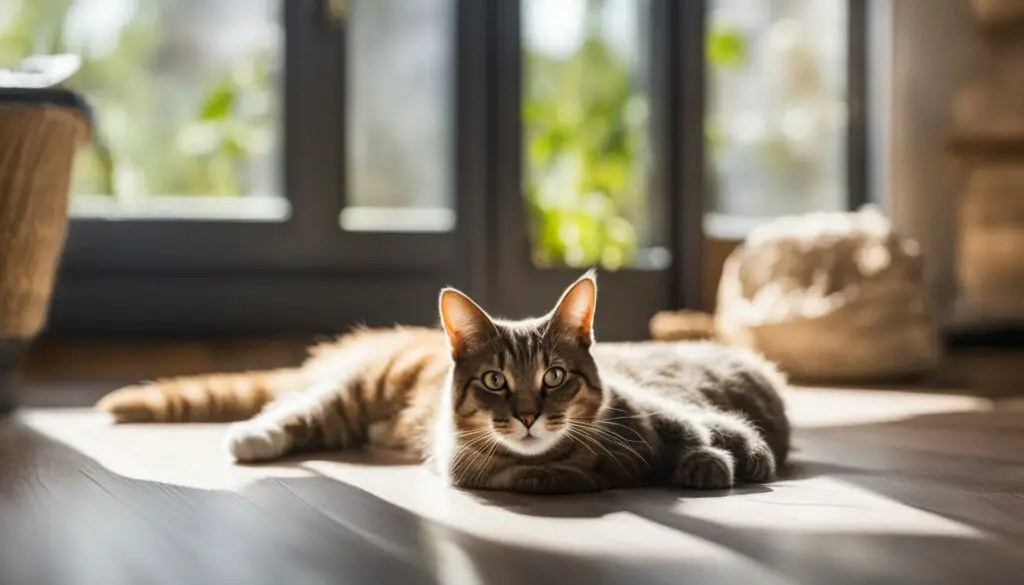
The Room’s Ventilation: Ensuring Fresh Air for the Cat
Proper ventilation is crucial in a confinement room to ensure the cat has access to fresh air and maintain good air quality. Cats are sensitive to odors and can be prone to respiratory issues, so it’s essential to create a well-ventilated space. Opening windows for a few minutes in the morning and evening can help circulate the air and bring in fresh oxygen. If the room doesn’t have windows or if it’s not possible to open them, using an air purifier can be an effective solution to filter out allergens, dust, and other airborne particles.
In addition to ventilation, it’s important to prevent the build-up of moisture or dampness in the room, as it can lead to mold growth and affect the cat’s health. Regularly check for any signs of condensation or water leaks, and promptly address them to maintain a dry environment. Ensuring proper ventilation and air quality will contribute to the overall well-being of the cat during confinement.
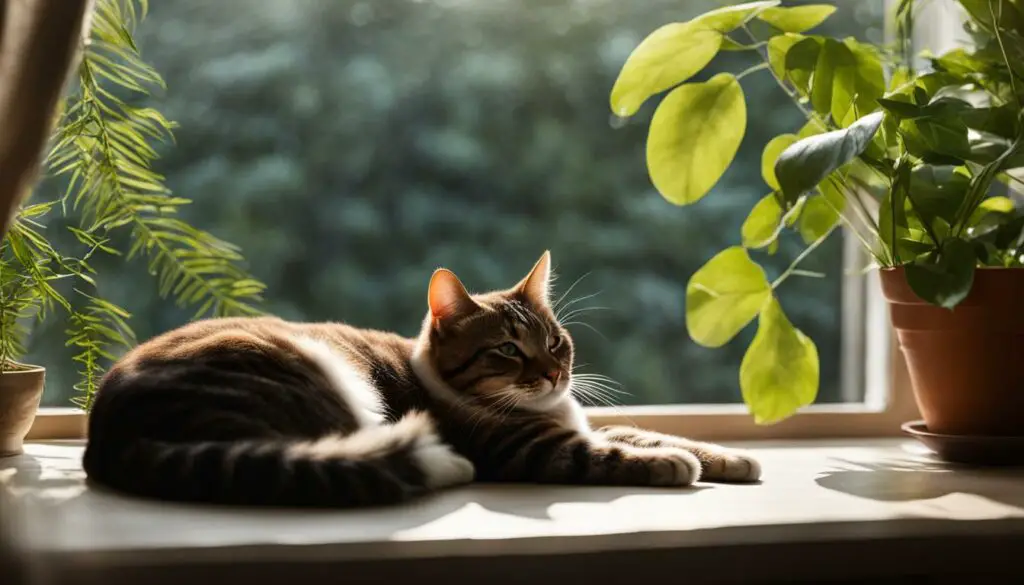
Fresh Air for a Contented Cat
“Fresh air is vital for a cat’s respiratory health and overall comfort. Proper ventilation in the confinement room ensures the cat’s well-being and reduces the risk of respiratory issues. By providing access to fresh air and maintaining good air quality, we create a comfortable environment where cats can thrive.”
Table: Ventilation Tips for Cat Confinement Rooms
| Tip | Description |
|---|---|
| Open windows | Allow fresh air circulation by opening windows for a few minutes in the morning and evening. |
| Use an air purifier | Filter out allergens and particles with an air purifier designed for pet households. |
| Prevent moisture | Regularly check for moisture or dampness and address any issues promptly to avoid mold growth. |
By following these ventilation tips, you can ensure a well-ventilated and comfortable environment for your cat during confinement. Prioritizing fresh air and good air quality will contribute to their overall health and happiness.
The Room’s Temperature: Keeping the Cat Comfortable
When confining a cat to a room at night, it is crucial to maintain a comfortable temperature for the cat’s well-being. Cats are sensitive to extreme temperature changes, so it’s important to ensure the room stays within a specific temperature range. The recommended temperature range for a cat’s confinement room is between 65 and 75°F. This temperature range provides a comfortable environment that supports the cat’s physiological functions and overall comfort.
In colder months, it’s important to provide adequate heating to prevent the room from becoming too cold for the cat. This can be achieved by using a space heater or by ensuring that the central heating system adequately warms the room. It’s important to monitor the temperature regularly and make adjustments as needed to keep the room within the recommended range.
On the other hand, during warmer months, it’s essential to keep the room cool to prevent the cat from overheating. This can be achieved by using fans or air conditioning to maintain a comfortable temperature. It’s crucial to ensure proper ventilation in the room to allow fresh air to circulate, promoting the cat’s respiratory health. Opening windows or using an air purifier can help maintain good air quality.

Tips for Maintaining the Room’s Temperature:
- Monitor the room’s temperature regularly to ensure it stays within the recommended range.
- Use heating devices or central heating systems to keep the room warm in colder months.
- Utilize fans or air conditioning to cool the room during warmer months.
- Ensure proper ventilation in the room to promote good air quality.
The room’s temperature is a vital aspect to consider when confining a cat to a room at night. Providing a comfortable temperature range helps ensure the cat’s well-being and overall comfort. It’s crucial to monitor the temperature regularly, make adjustments as needed, and maintain proper ventilation to create a pleasant environment for the cat.
The Cat’s Personality: Considering Individual Needs
When it comes to confining a cat to a room at night, it’s important to take the cat’s personality into consideration. Every cat is unique, with their own set of needs and preferences. Some cats may thrive in confinement, while others may become stressed and anxious. By observing and understanding your cat’s behavior, you can provide a confinement routine that suits their individual needs.
Cats have varying levels of tolerance for confinement. Some may adapt well to being confined in a room, finding comfort in the safe and secure environment. These cats may appreciate having their own space at night and may even enjoy the solitude. On the other hand, some cats may find confinement distressing. They may become anxious or depressed when confined for long periods, exhibiting signs of aggression or destructive behavior.
As a responsible cat owner, it is crucial to pay attention to your cat’s behavior during confinement. Watch for any signs of stress or discomfort, such as excessive vocalization, pacing, or attempts to escape. If you notice these signs, consider adjusting the confinement routine to better suit your cat’s needs. For example, you could gradually increase the duration of confinement, provide more interactive toys and stimulation, or even consult with a veterinarian or animal behaviorist for professional advice.
Each cat has their own personality and unique set of needs. It’s our responsibility as cat owners to respect and accommodate those needs, even when it comes to confining them to a room at night. By observing and understanding our cat’s behavior, we can create a confinement routine that promotes their well-being and ensures their comfort.
The Cat’s Basic Needs: Providing Necessities in Confinement
When confining a cat to a room at night, it is crucial to ensure that their basic needs are met. This includes providing them with essential supplies and creating an environment that promotes their well-being.
Food and Water
The confinement room should have a designated area for food and water bowls. Ensure that these are easily accessible to the cat and kept clean. Provide fresh water daily and feed the cat according to their dietary needs. If the cat is on a specialized diet or requires medication, consult with a veterinarian for appropriate feeding instructions.
Litter Boxes
Place at least one litter box in the confinement room, ensuring that it is large enough for the cat to comfortably use. Consider providing multiple litter boxes if you have more than one cat. Scoop the litter box daily and change the litter regularly to maintain cleanliness and prevent odor buildup.
Stimulation and Enrichment
Keeping a cat mentally and physically stimulated is vital during confinement. Provide toys, scratching posts, and interactive games to keep them engaged. Consider rotating toys to prevent boredom. Additionally, provide a comfortable bed or blanket for the cat to rest and sleep on.
Creating a stimulating environment can help prevent behavioral problems and promote a sense of security for the cat.
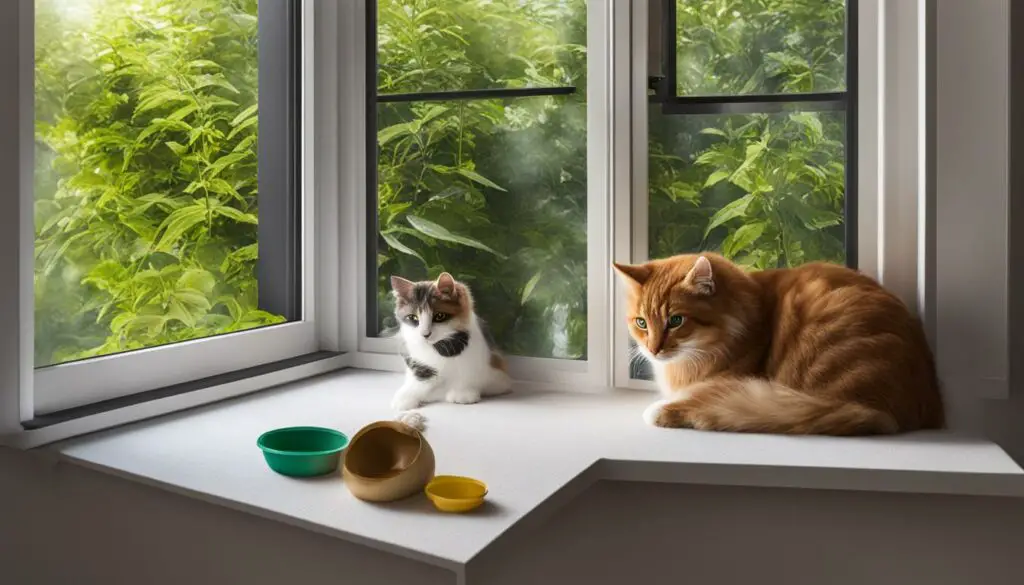
Safety Considerations
Ensure that the confinement room is free from any potential hazards. Check for loose wires, toxic plants, or small objects that the cat could swallow. Secure any loose furniture or shelves to prevent accidents. If there are windows, make sure they are secured and inaccessible to the cat to avoid any falls or injuries.
Regularly inspect the confinement room for any potential safety concerns and address them promptly to maintain a safe environment for the cat.
By providing the necessary essentials and creating a safe and stimulating environment, you can help ensure the well-being and comfort of your cat during confinement.
The Room’s Safety: Creating a Secure Environment for the Cat
When confining a cat to a room at night, ensuring the room’s safety is of utmost importance. By creating a secure environment, you can protect your cat from potential hazards and provide them with a comfortable confinement experience.
To cat-proof the confinement room:
- Remove any items that could be swallowed or pose a choking hazard.
- Secure electrical cords and outlets to prevent electrocution.
- Replace unstable furniture or secure it to the wall to prevent accidents.
- Ensure there are no toxic plants or chemicals within the room.
Additionally, if there are other animals in the house, make sure they cannot access the confinement room to prevent any potential conflicts or injuries. Creating a safe and secure space will give you peace of mind knowing that your cat is protected and can freely move around without any risks.
| Room Safety Checklist | Status |
|---|---|
| Remove potential choking hazards | ✓ |
| Secure electrical cords and outlets | ✓ |
| Stable furniture or secured to the wall | ✓ |
| No toxic plants or chemicals | ✓ |
| Prevent access to other animals | ✓ |
Proper Introduction and Training for Confinement
Introducing a cat to confinement requires a gradual approach to minimize stress and anxiety. Instead of confining the cat for a full night right away, it is recommended to start with shorter periods of confinement and gradually increase the duration over time. This allows the cat to become familiar with the confinement routine and adjust more easily.
During the introduction phase, it is important to create a positive association with the confinement room. Place the cat’s favorite toys, bedding, and treats in the room to make it a comforting and inviting space. Additionally, using calming pheromones or leaving an item with your scent can help ease the cat’s anxiety.
When the cat is in the confinement room, it is crucial not to reinforce negative behavior. Ignoring the cat’s cries or attempts to escape will prevent them from associating those actions with getting out of the room. Instead, provide positive experiences during the confinement period, such as interactive play sessions or quiet bonding time.
By following a gradual introduction and training process, cats can adapt to confinement more easily, reducing stress and promoting a positive confinement experience.
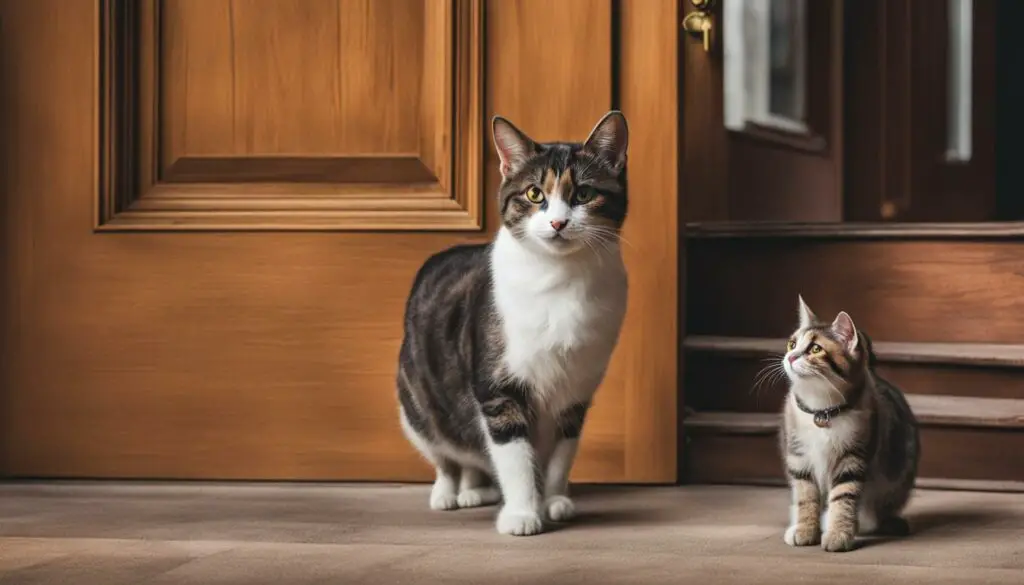
Tips for Introducing Cats to Confinement
- Start with short periods of confinement and gradually increase the duration.
- Make the confinement room inviting with the cat’s favorite toys, bedding, and treats.
- Use calming pheromones or leave an item with your scent to help ease anxiety.
- Ignore the cat’s cries or attempts to escape to prevent reinforcing negative behavior.
- Provide positive experiences during confinement, such as interactive play or quiet bonding time.
“Introducing cats to confinement requires patience and a gradual approach to ensure their comfort and well-being.”
Valid Reasons for Keeping a Cat Confined at Night
While it is generally not recommended to confine a cat to a room at night, there are valid reasons for doing so. Confinement can provide safety and comfort for the cat in certain situations.
One of the main reasons for confining a cat at night is when they are recovering from an illness or surgery. Keeping them in a confined space can help prevent further injury or complications, allowing them to heal properly.
Another valid reason for confinement is to protect the cat from potential dangers outside. If the cat lives in an area with many wild animals or other cats that may pose a threat, keeping them confined to a safe room at night can provide the necessary protection.
Confinement at night can also be beneficial when introducing a rehomed cat to a new environment. It allows them to adjust gradually and feel secure in their new surroundings.
Lastly, confinement may be necessary when the cat needs to be separated from other pets or allergic individuals in the household. This helps to reduce potential conflicts or allergic reactions, ensuring the well-being of everyone involved.

Confinement at night can provide safety and comfort for cats in certain situations, such as during recovery from illness or surgery, protection from potential dangers outside, introduction to a new environment, and separation from other pets or allergic individuals in the household.
The Cruelty Debate: Is Confinement Cruel to Cats?
The debate surrounding the confinement of cats to a room at night raises important questions about the well-being and happiness of our feline companions. While some argue that confining cats is inherently cruel, others believe it can be a necessary practice when done correctly, ensuring the safety and comfort of the cat. To truly understand the topic, we must explore both perspectives and consider various factors.
On one hand, opponents of cat confinement argue that it deprives cats of their natural freedom and inhibits their ability to engage in instinctual behaviors, such as hunting and exploring. They believe that confining a cat to a room restricts their physical and mental stimulation, leading to boredom, frustration, and potential health issues. Critics also question the ethics of confining a highly independent and territorial animal like a cat.
On the other hand, proponents of cat confinement argue that it can be a beneficial practice in certain situations. For example, if a cat lives in an environment with potential dangers, such as high traffic areas or predators, confining them to a safe room at night can protect them from harm. Additionally, confinement may be necessary during a cat’s recovery from illness or surgery, providing a quiet and controlled environment for healing.
“The level of cruelty depends on various factors.”
In order to determine whether confinement is cruel to cats, it is essential to consider the individual cat’s temperament, the conditions of the confinement room, and the duration of confinement. Some cats may adapt well to being confined, while others may experience significant distress. The confinement room should be comfortable, stimulating, and meet the cat’s basic needs, including adequate space, proper ventilation, and access to food, water, and litter boxes. Furthermore, regular monitoring and adjustment of the confinement routine can help ensure the cat’s well-being.
In conclusion, the debate on the cruelty of confining cats to a room at night is complex and multifaceted. While some argue that it is cruel to restrict a cat’s freedom, others believe that confinement can be a necessary and beneficial practice when done correctly. It is crucial to consider the individual cat’s needs, create a conducive and stimulating environment, and monitor their well-being during confinement. By doing so, we can strive to provide the best possible care for our feline companions.
Dos and Don’ts of Confining a Cat to a Room at Night
When it comes to confining a cat to a room at night, there are certain dos and don’ts to keep in mind to ensure the well-being of your feline friend. Here are some tips for cat room confinement:
- Do provide the cat with its basic needs: Ensure that the room has food, water, litter boxes, and stimulating activities to keep your cat comfortable and entertained during their time in confinement.
- Do use calming pheromones or your own scent: Introduce familiar scents, such as your own or calming pheromones, to help create a sense of security and calm for your cat in the confinement room.
- Do monitor the temperature and ventilation of the room: It’s important to maintain a comfortable temperature range (between 65 and 75°F) and ensure proper ventilation to provide fresh air for your cat.
- Do check on the cat regularly: Regularly visit the cat in the confinement room to ensure their well-being, provide social interaction, and address any potential concerns or needs.
While there are important dos to consider, there are also certain don’ts to avoid when confining a cat to a room at night:
- Don’t confine the cat for a full night at once: Start with shorter confinement periods and gradually increase the duration to allow your cat to acclimate to the confinement routine.
- Don’t use confinement as a punishment: Confinement should be seen as a safe and comfortable space for your cat, not a form of punishment. Avoid using confinement as a disciplinary measure.
- Don’t lock the cat in an unsafe room: Ensure that the confinement room is free from potential hazards, such as exposed wires or items that could be swallowed, to keep your cat safe while confined.
By following these dos and don’ts, you can create a positive and safe environment for your cat when confining them to a room at night.
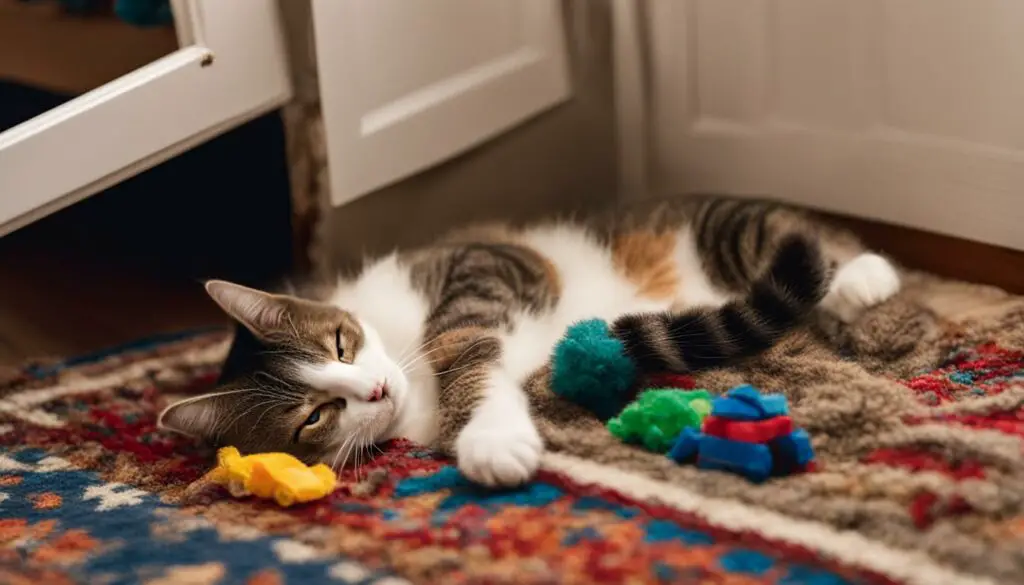
Conclusion
After exploring the topic of confining cats to a room at night, it is clear that this practice is a controversial one. While it is generally considered inhumane to confine cats due to their need for freedom and movement, there are situations where confinement may be necessary for their safety and well-being.
When considering confining a cat to a room at night, several factors need to be taken into account. These include the size of the room, ventilation, temperature, the cat’s personality, and their basic needs. Providing a room with enough space for the cat to move comfortably, ensuring proper ventilation and temperature, and considering the individual needs of the cat are all important considerations.
While it is generally discouraged to confine cats, there are valid reasons to do so. These include situations where the cat is recovering from an illness or surgery, protecting them from potential dangers outside, allowing them to adjust to a new environment, or when separation is necessary for the well-being of other pets or individuals with allergies.
It is crucial to create a safe and stimulating environment when confining a cat to a room at night. By considering their needs, providing the essentials, ensuring safety, and gradually introducing and training them to confinement, we can minimize any potential harm or distress. It is essential to monitor the cat’s well-being and behavior during confinement to ensure their comfort and minimize any negative impact.
FAQ
Is it cruel to confine a cat to a room at night?
Confining a cat to a room at night can be controversial, but there may be situations where it is necessary for their safety and well-being.
What factors should I consider when confining a cat to a room at night?
Factors to consider include the size of the room, ventilation, temperature, the cat’s personality, and providing for their basic needs.
How much space should I provide for a cat in a confinement room?
The minimum recommended space for a confinement room is 18 square feet, but it is important to consider the individual needs of the cat.
How can I ensure proper ventilation in the confinement room?
Good ventilation can be achieved by opening windows, using an air purifier, and preventing moisture build-up in the room.
What temperature range is suitable for a cat’s confinement room?
The recommended temperature range for a cat’s confinement room is between 65 and 75°F.
How should I consider a cat’s personality in confinement?
Some cats may not tolerate being confined for long periods, so it is important to observe their behavior and adjust the confinement routine accordingly.
What basic needs should I provide for a cat in a confinement room?
Basic needs include food, water, litter boxes, and stimulating activities to prevent boredom.
How can I create a safe environment in the confinement room?
Remove hazards, secure electrical outlets, and ensure other animals cannot access the room.
How can I properly introduce and train a cat to confinement?
Gradually increase the duration of confinement, provide positive experiences, and avoid reinforcing negative behavior.
When is it appropriate to confine a cat to a room at night?
It may be appropriate when the cat is recovering from an illness, needs protection from potential dangers, or needs to be separated from other pets or allergic individuals.
Is confining a cat at night considered cruel?
The debate on the cruelty of cat confinement is ongoing, but providing a comfortable and stimulating environment can help minimize any potential harm or distress.
What are the dos and don’ts of confining a cat to a room at night?
Do provide basic needs, monitor temperature and ventilation, and don’t confine the cat for a full night at once or use confinement as punishment.
What should I consider when concluding whether to confine a cat at night?
Consider the cat’s well-being, individual needs, and minimize any potential distress or harm.







